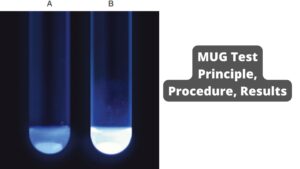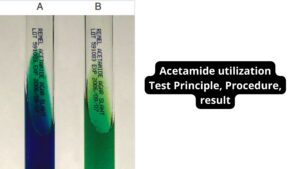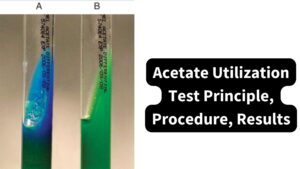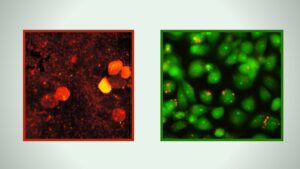| Test Name | Cetrimide Agar Test |
| Detection | Pseudomonas aeruginosa |
| Uses | To separate Pseudomonas aeruginosa and other gram-negative bacilli that don’t ferment and try to figure out what they are. The purpose of the test is to see if an organism can grow in the presence of cetrimide. |
| Result | A blue-green colouring around the growth |
| Require | Cetrimide Agar, Wood’s or UV light (360 nm) or short-wavelength (254-nm) UV light, Sterile inoculating loops or sticks |
| Quality Control | Positive: Pseudomonas aeruginosa (ATCC27853)—growth and color change; yellow-green to blue-green colonies Negative: Escherichia coli (ATCC25922)—no growth and no color change |
Cetrimide Agar Test
- Cetrimide Selective Agar is a solid medium that is recommended for use in qualitative procedures for selective isolation and presumed identification of Pseudomonas aeruginosa and other nonfermenting, gram-negative bacilli.
- Pseudomonas aeruginosa grows well on all normal lab media, but it is best to isolate the organism from the environment or from a human, animal, or plant source on a medium that has a selective agent and also parts that help pigment production.
- Most selective media are based on how resistant a species is by nature to different antibacterial agents.
- Cetrimide stops many microorganisms from growing, but it doesn’t stop Pseudomonas aeruginosa from making normal colonies.
- Cetrimide is a quaternary ammonium salt that works as a cationic detergent to reduce surface tension at the point of contact and has effects on bacterial membrane proteins that include precipitating, complexing, and denature.
- It stops a wide range of microorganisms from growing, including other types of Pseudomonas than Pseudomonas aeruginosa.
- King and his colleagues came up with Medium A to help Pseudomonas make more pyocyanin.
- Cetrimide Agar was made by Lowburry. It is a change to Tech Agar (Medium A) that adds 0.1% cetrimide to help isolate P. aeruginosa.
- Later, when the highly purified cetrimide was available, the amount of it in the medium was cut down.
- The incubation took place at 37°C for 18–24 hours. P. aeruginosa can be recognised by the fact that it makes pyocyanin, a blue, water-soluble, nonfluorescent phenazine pigment, and by the fact that its colonies look like grapes and smell like aminoacetophenone.
- Pyocyanin is only known to come out of P.aeruginosa, which is a gram-negative rod.
- Because of this, these media are important for figuring out what P.aeruginosa is. These media are used to test for the presence of P.aeruginosa in cosmetics and clinical samples, as well as to see how well disinfectants work against this organism.
- Gelatin and peptone give P.aeruginosa the nutrients it needs.
- The osmotic balance in the medium is kept by sodium chloride.
- Pyocyanin production is boosted by magnesium chloride and potassium sulphate.
- For P.aeruginosa to be found, nonselective medium like Brain Heart Infusion Broth (M210) or Soyabean Casein Digest Medium should be spread on plates of Cetrimide Agar (M011).
- If the number is high, the test sample can be put right onto the Cetrimide Agar.
- Colonies of P.aeruginosa can look blue, blue-green, or not coloured at all.
- Colonies that glow blue-green at 250nm and fluoresce at that wavelength are thought to be positive.
- If the cultures of P.aeruginosa are left at room temperature for a short time, the bacteria may lose their ability to glow under UV light.
- When the plates are put back in the oven, the fluorescence comes back. How pigments are made may also depend on the type of peptone used in the base.
- Some types of P.aeruginosa may not be able to make pyocyanin.
- Other types of Pseudomonas don’t make pyocyanin, but they do fluoresce when exposed to UV light.
- Most species that aren’t Pseudomonas are stopped from growing on Cetrimide Agar, and some Pseudomonas species may also be stopped.
- Some organisms that don’t ferment and some that make spores in an aerobic environment may show a water-soluble tan to brown colour on this medium. Serratia might have pink colouring.
- To confirm the results, biochemical tests and serological tests should be done.
Purpose of Cetrimide Test
- To separate Pseudomonas aeruginosa and other gram-negative bacilli that don’t ferment and try to figure out what they are.
- The purpose of the test is to see if an organism can grow in the presence of cetrimide.
Principle of Cetrimide Test
Pyocyanin is a blue-green, water-soluble, nonfluorescent phenazine pigment that is made by P. aeruginosa. Pyocyanin and fluorescein are made when potassium sulphate and magnesium chloride are present. To see fluorescein being made, an ultraviolet light is used. Cetrimide (N-acetyl-NNN-trimethyl-ammonium bromide, or Cetavlon) stops the growth of bacteria other than P. aeruginosa by causing nitrogen and phosphorus to leak out of bacterial cells.
Requirements for Cetrimide Test
- Cetrimide Agar
- Sterile inoculating loops or sticks
- Wood’s or UV light (360 nm) or short-wavelength (254-nm) UV light
Composition of Cetrimide Agar
| Ingredients | Gms / Litre |
| Gelatin peptone | 20.000 |
| Magnesium chloride | 1.400 |
| Potassium sulphate | 10.000 |
| Cetrimide | 0.300 |
| Agar | 15.000 |
| Final pH ( at 25°C) | 7.2±0.2 |
Procedure
Preparation of Cetrimide Agar Media
- Mix 46.7 grammes with 10 ml of glycerol in 1000 ml of purified or distilled water.
- Bring the medium to a boil to dissolve it completely.
- Use an autoclave for 15 minutes at 15 pounds of pressure (121°C) and 121°F.
- Bring the temperature down to 45-50°C.
- If you want to, you can add the rehydrated contents of 1 vial of Nalidixic Selective Supplement (FD130) to 1000 ml of medium in a clean way.
- Mix well and pour into Petri plates that have been cleaned.
Cetrimide Agar Test Procedure
- As soon as the sample gets to the lab, it should be inoculated and put on a plate. Both selective and nonselective media should be used to increase the chance of finding low numbers of gram-negative organisms and to make sure that other organisms in the sample can be kept separate.
- If you want to grow something from a swab, roll the swab over a small area of the agar surface and make a streak.
- Incubate Cetrimide Agar at 33–37°C for 18–24 hours in the air around it. Note: If slants are used, the caps on the tubes should be loosened while they are incubated.
- Look for the typical shape of the colony and the typical blue-green coloration around the growth. Check colonies for yellow-green fluorescence with a long-wave ultraviolet light (254 nm). If the medium doesn’t have any normal colonies, put it back in the incubator for another 24 hours.
- More biochemical tests must be done on colonies that are a possible threat.
Result and Interpretation of Cetrimide Agar Test

Pyocyanin Production
- Positive Test: There is blue-green colouring around the growth
- Negative Test: No change in colour
Fluorescein Production (requires the use of ultraviolet light)
- Positive Test: Fluorescence in yellow and green
- Negative Test: No fluorescence on a negative test.
Reporting
- P. aeruginosa is definitely found in gram-negative, oxidase-positive bacilli that grow on cetrimide agar and make a blue-green pigment called pyocyanin.
- Pseudomonas fluorescens and Pseudomonas putida can also grow on cetrimide agar and make a fluorescent pigment, but they are different from P. aeruginosa because they don’t grow at 42°C.
| Organism | Result (Growth) |
| Pseudomonas aeruginosa | growth (green-yellow to blue-green colonies) |
| Escherichia coli | inhibited |
| Pseudomonas putide | Adequate growth |
| Stenotrophomonas maltophila | inhibited |
| Staphylococcus aureus | inhibited |
| Salmonella Typhimurium | inhibited |
| Proteus mirabilis | inhibited |
Note: Cetrimide Agar is used to find and isolate Pseudomonas aeruginosa that makes pigment. Pseudomonas aeruginosa makes many pigments that dissolve in water. The amount of pigment made can be seen by looking at the colour of the colonies on the plates. Pyocyanin is a blue phenazine pigment that mixes with pyoverdin, a yellow pigment, to give P. aeruginosa its bright green colour. Most of the time, pyocyanin gives colonies a blue-green colour, but sometimes colonies can take on a light aqua or dark blue colour. Fluorescein is another colour that Pseudomonas often makes. Fluorescein appears as a bright yellow-green halo around colonies that fluoresce under short wavelength UV (254-nm) (254-nm). It should be noted that non-pigmented strains of P. aeruginosa can sometimes be found, and growth on Cetrimide Agar is a sign of a positive result. Pseudomonas aeruginosa also makes the pink to red pigment pyurubin, which is often made at the same time as pyocyanin and/or fluorescein. Isolated colonies from pure culture should go through more biochemical and/or serological tests so that they can be fully identified.
Phenotypic differentiation of the most important Pseudomonads
| Characteristic | P. aeruginosa | P. fluoreszens | P. putida | P. stutzeri |
| Oxidase | Positive | Positive | Positive | Positive |
| Growth at 41 °C | Positive | Negative | Negative | Positive/Negative |
| Pyoverdin („Fluorescein“) | Positive | Positive | Positive | Negative |
| Pyocyanin | Positive | Negative | Negative | Negative |
| Gelatinase | Positive | Positive | Negative | Negative |
Quality Control
Using the following quality control organisms, all lot numbers of Cetrimide Agar have been evaluated and verified to be acceptable. The examination of control organisms should adhere to recognised laboratory quality control protocols. Patient outcomes should not be published if abnormal quality control results are observed.
- Positive: Pseudomonas aeruginosa (ATCC27853)—growth and color change; yellow-green to blue-green colonies
- Negative: Escherichia coli (ATCC25922)—no growth and no color change
Limitations of Cetrimide Agar Test
- Some strains may develop badly or not at all on this medium as a result of nutritional variance.
- On this media, several non-fermenters and aerobic spore formers may exhibit a water-soluble tan to brown colouring. Strains of Serratia may have a pink hue.
- Additional tests are required to establish the presence of Pseudomonas aeruginosa.
- On Cetrimide Selective Agar, certain enteric gram-negative bacilli may thrive and generate a mild discoloration of the medium. The absence of fluorescence distinguishes this yellow hue from fluorescein.
- Only P. aeruginosa among the pseudomonads is known to excrete pyocyanin and generate pyorubin concurrently with pyocyanin and/or fluorescein. Pyorubin is a pigment that is pink to crimson or dark maroon.
- Occasionally, P. aeruginosa strains are incapable of producing pyocyanin.
- If the cultures are left at room temperature for a brief period, P. aeruginosa may lose its fluorescence under ultraviolet light. When plates are reincubated, fluorescence resumes.
- As cetrimide is highly toxic, this medium is selective, and certain strains may grow poorly in it.
- According to the current EP and USP guidelines, Cetrimide Agar is incubated for 18-72 hours at 30-35 degrees Celsius.
- In addition to Pseudomonas aeruginosa, Pseudomonas putida and Pseudomonas fluorescens can grow at 30 °C to 35 °C on Cetrimide Agar, however Burkholderia cepacia and Stenotrophomonas maltophilia are inhibited. B. cepacia may grow at an incubation temperature of approximately 25 degrees Celsius.
Cetrimide Agar Test Uses
- Utilized to isolate Pseudomonas aeruginosa from water and clinical samples.
- Used to determine an organism’s capacity to tolerate cetrimide and thrive on cetrimide agar.
References
- https://clinmicronow.org/doi/10.1128/9781683670438.CMPH.ch3.17-11
- https://tools.thermofisher.com/content/sfs/manuals/IFU1292.pdf
- https://www.dalynn.com/dyn/ck_assets/files/tech/TC42.pdf
- https://www.himedialabs.com/TD/M024.pdf
- https://www.sigmaaldrich.com/deepweb/assets/sigmaaldrich/product/documents/150/874/tn1343en-mk.pdf
- https://www.nelabservices.com/pdf/tech-sheets/cetrimide-agar-2016.pdf
- https://www.neogen.com/globalassets/pim/assets/original/10007/ncm0109_ts_en-us.pdf
- http://biotrading.com/assets/productinformatie/acumedia/tds/7222.pdf
- https://microbenotes.com/cetrimide-agar-test-principle-procedure-and-result-interpretation/
- https://microbeonline.com/cetrimide-agar-composition-principle-preparation-uses/



